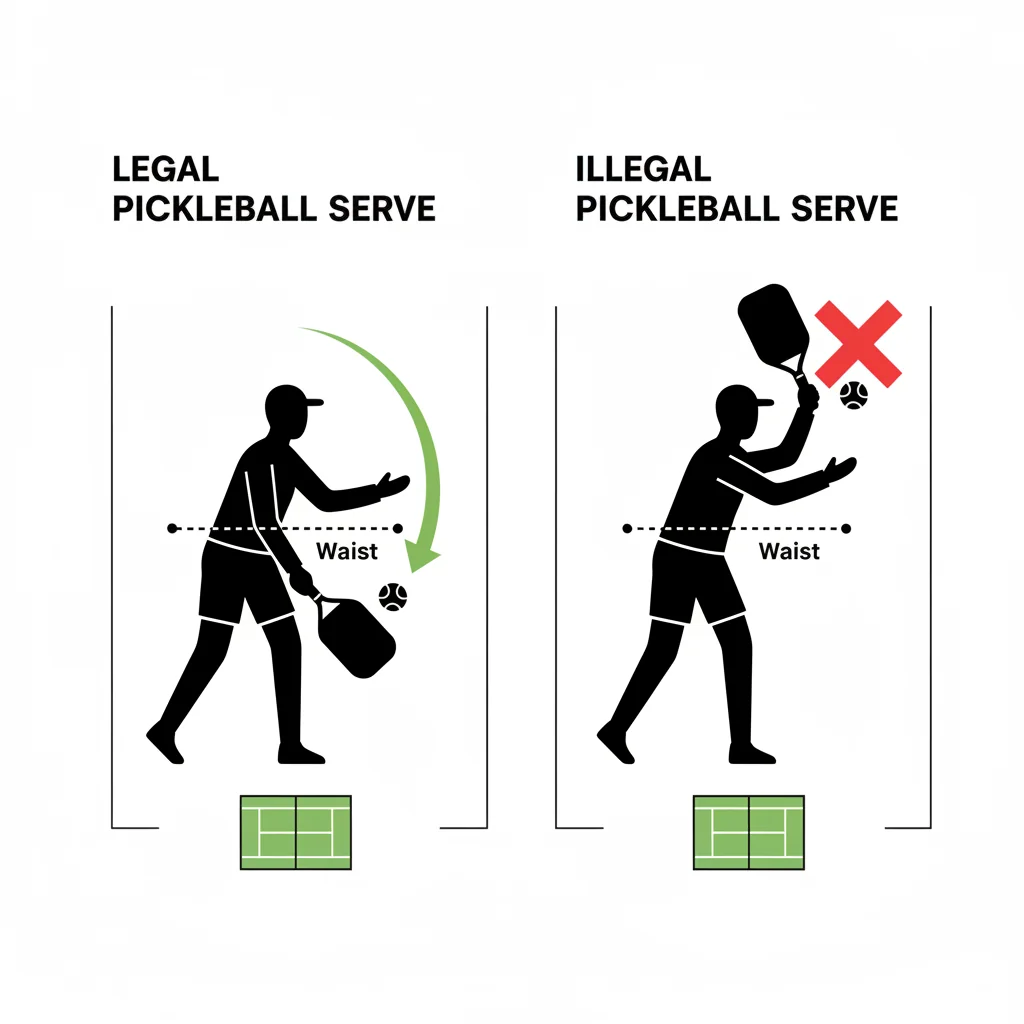The 5 Core Serving Rules in Pickleball: A Beginner's Guide

The serve is the single most important shot in pickleball—it starts every single rally. But if you're new to the game, the serving rules can feel a bit confusing. Is it underhand only? Where can my feet be? Getting it right is the key to starting the point correctly and building your confidence on the court.
This guide will clearly and simply break down exactly what are the 5 serving rules in pickleball, ensuring your serve is legal and effective every time.
What are the 5 main serving rules in pickleball?
The five main serving rules in pickleball are: 1. Underhand Motion: The paddle must strike the ball in an upward motion. 2. Below the Waist: Contact with the ball must be made below your navel. 3. Feet Behind the Line: At least one foot must be behind the baseline, and neither foot can touch the court or baseline until after the ball is struck. 4. Serve to Diagonal Court: The serve must land in the service court diagonally opposite you, beyond the non-volley zone line. 5. Choice of Serve Type: You can use either a Volley Serve (hitting the ball out of the air) or a Drop Serve (hitting the ball after it bounces once).
In This Guide
Rule #1: The Motion Must Be Underhand
The most fundamental of all pickleball rules on serving is the motion. Your arm must move in an upward arc when you strike the ball. This prevents players from smashing an aggressive, overhead serve like in tennis.
Think of it like a bowling motion or a gentle upward swing. Additionally, the highest point of your paddle head must be below your wrist at the moment of contact. This ensures the motion remains a serve, not a flick or a side-arm smash.
Rule #2: Contact Must Be Below the Waist
This rule works in tandem with the underhand motion. You must make contact with the pickleball below your navel. This is another key element that keeps the serve from becoming an overly aggressive attack.
Imagine a horizontal line across your belly button—your paddle must connect with the ball somewhere below that line. This is one of the most common faults for new players, so it's a great habit to practice.
Common Mistake: The High Serve
Many beginners accidentally make contact with the ball around their chest or stomach. A good self-check is to place your free hand on your navel while practicing to get a feel for the correct contact height.

A legal serve (left) shows contact below the waist with an upward swing. An illegal serve (right) often involves contact that is too high or a downward, tennis-style swing.
Rule #3: Keep Your Feet Behind the Baseline
Your position on the court is critical. When you serve, you must keep at least one foot behind the baseline. Furthermore, neither of your feet can touch the baseline or step into the court until after your paddle makes contact with the ball.
Here’s a simple breakdown:
- Starting Position: Both feet must be behind the baseline.
- During the Serve: You can step on or over the baseline, but only after the ball has been struck.
- Centerline & Sideline: You also cannot touch the imaginary extensions of the centerline or sideline with your feet during the serve.
Rule #4: Serve into the Correct Diagonal Service Court
The serve isn't just about how you hit the ball, but also where it lands. Your serve must travel cross-court and land in the service area that is diagonally opposite from where you are standing.
- The ball must clear the Non-Volley Zone (the 'Kitchen').
- It must land within the lines of the diagonal service court.
- If the ball lands on any line (except the Non-Volley Zone line), it is considered in.
Rule #5: Choose Your Serve Type: Volley or Drop
This is a newer rule that gives players options. You have two ways to legally begin your serve:
The Volley Serve: This is the traditional method. You hold the ball in your non-paddle hand, release it, and strike it out of the air. All the rules we've discussed (underhand, below the waist, etc.) apply to the Volley Serve.
The Drop Serve: This is a simpler option. You can drop the ball from any height (unaided, just let it fall) and let it bounce once on the court before you hit it. After the bounce, you can hit the ball however you like—the underhand motion and paddle position rules do not apply to a drop serve. This makes it a fantastic, easy-to-learn option for beginners.
Pro Tip for Beginners
If you're just starting, try the drop serve! It's much easier to master because you don't have to worry about the tricky underhand motion rules. It allows you to focus simply on getting the ball over the net and in the correct box.
Frequently Asked Questions About Pickleball Serving
Can the ball hit the net on a pickleball serve?
Yes. If a serve hits the net and then lands in the correct service court, it is a live ball and the rally continues. This is called a 'let,' and unlike in tennis, you do not replay the point. The receiving team must play the ball.
Do I have to serve underhand in pickleball?
Yes, for a traditional volley serve. The motion must be an upward arc with contact below the waist. However, if you use the drop serve (letting the ball bounce once before hitting), you are not required to use an underhand motion.
What happens if my foot touches the baseline during my serve?
If your foot touches the baseline or the court before you make contact with the ball, it is a 'foot fault.' You lose the serve, and the point goes to your opponent (or it results in a side-out if you are the first server).